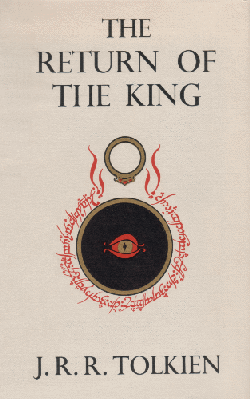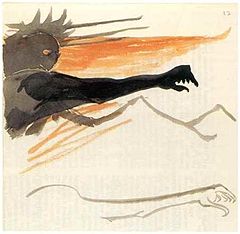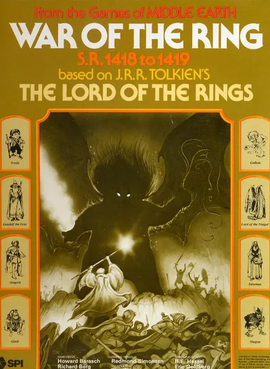Denethor II, son of Ecthelion II, is a fictional character in J. R. R. Tolkien's novel The Lord of the Rings. He was the 26th ruling Steward of Gondor, committing suicide in the besieged city of Minas Tirith during the Battle of the Pelennor Fields.

Gondor is a fictional kingdom in J. R. R. Tolkien's writings, described as the greatest realm of Men in the west of Middle-earth at the end of the Third Age. The third volume of The Lord of the Rings, The Return of the King, is largely concerned with the events in Gondor during the War of the Ring and with the restoration of the realm afterward. The history of the kingdom is outlined in the appendices of the book.
A palantír is one of several indestructible crystal balls from J. R. R. Tolkien's epic-fantasy novel The Lord of the Rings. The word comes from Quenya palan 'far', and tir 'watch over'. The palantírs were used for communication and to see events in other parts of Arda, or in the past.

The Return of the King is the third and final volume of J. R. R. Tolkien's The Lord of the Rings, following The Fellowship of the Ring and The Two Towers. It was published in 1955. The story begins in the kingdom of Gondor, which is soon to be attacked by the Dark Lord Sauron.
Elendil is a fictional character in J. R. R. Tolkien's legendarium. He is mentioned in The Lord of the Rings, The Silmarillion and Unfinished Tales. He was the father of Isildur and Anárion, last lord of Andúnië on the island of Númenor, and having escaped its downfall by sailing to Middle-earth, became the first High King of Arnor and Gondor. In the Last Alliance of Men and Elves, Elendil and Gil-galad laid siege to the Dark Lord Sauron's fortress of Barad-dûr, and fought him hand-to-hand for the One Ring. Both Elendil and Gil-galad were killed, and Elendil's son Isildur took the Ring for himself.
Minas Tirith is the capital of Gondor in J. R. R. Tolkien's fantasy novel The Lord of the Rings. It is a seven-walled fortress city built on the spur of a mountain, rising some 700 feet to a high terrace, housing the Citadel, at the seventh level. Atop this is the 300-foot high Tower of Ecthelion, which contains the throne room.
The Battle of the Pelennor Fields, in J. R. R. Tolkien's novel The Lord of the Rings, was the defence of the city of Minas Tirith by the forces of Gondor and the cavalry of its ally Rohan, against the forces of the Dark Lord Sauron from Mordor and its allies the Haradrim and the Easterlings. It was the largest battle in the War of the Ring. It took place at the end of the Third Age in the Pelennor Fields, the townlands and fields between Minas Tirith and the River Anduin.
In J. R. R. Tolkien's epic fantasy novel The Lord of the Rings, the Battle of the Morannon or the Battle of the Black Gate, is the final confrontation in the War of the Ring. Gondor and its allies send a small army ostensibly to challenge Sauron at the entrance to his land of Mordor; he supposes that they have with them the One Ring and mean to use it to defeat him. In fact, the Ring is being carried by the hobbits Frodo Baggins and Sam Gamgee into Mordor to destroy it in Mount Doom, and the army is moving to distract Sauron from them. Before the battle, a nameless leader, the "Mouth of Sauron", taunts the leaders of the army with the personal effects of Frodo and Sam. Battle is joined, but just as it seems the army of Gondor will be overwhelmed, the Ring is destroyed, and the forces of Sauron lose heart. Mount Doom erupts, and Sauron's tower, Barad-dûr, collapses, along with the Black Gate. The army of Gondor returns home victorious, the War of the Ring won.
This page lists board and card games, wargames, miniatures games, and table-top tabletop role-playing games published in 1977. For video games, see 1977 in video gaming.

Games of Middle Earth is a trilogy of board games published by Simulations Publications, Inc. in 1977 that are all based on the epic fantasy novel The Lord of the Rings by J. R. R. Tolkien. It was a bestseller for SPI even before its publication, and remained at or near the top of SPI's Top Ten list for two years.
Faramir is a fictional character in J. R. R. Tolkien's The Lord of the Rings. He is introduced as the younger brother of Boromir of the Fellowship of the Ring and second son of Denethor, the Steward of Gondor. Faramir enters the narrative in The Two Towers, where, upon meeting Frodo Baggins, he is presented with a temptation to take possession of the One Ring. In The Return of the King, he leads the forces of Gondor in the War of the Ring, coming near to death, succeeds his father as Steward, and wins the love of Éowyn, lady of the royal house of Rohan.
In J. R. R. Tolkien's Middle-earth writings, the Dúnedain were a race of Men, also known as the Númenóreans or Men of Westernesse. Those who survived the sinking of their island kingdom and came to Middle-earth, led by Elendil and his sons, Isildur and Anárion, settled in Arnor and Gondor.
Peregrin Took, commonly known simply as Pippin, is a fictional character from J. R. R. Tolkien's fantasy novel The Lord of the Rings. He is closely tied with his friend and cousin, Merry Brandybuck, and the two are together during most of the story. Pippin and Merry are introduced as a pair of young hobbits of the Shire who become ensnared in their friend Frodo Baggins's quest to destroy the One Ring. Pippin joins the Fellowship of the Ring. He and Merry become separated from the rest of the group at the breaking of the Fellowship and spend much of The Two Towers with their own story line. Impetuous and curious, Pippin enlists as a soldier in the army of Gondor and fights in the Battle of the Morannon. With the other hobbits, he returns home, helps to lead the Scouring of the Shire, and becomes Thain or hereditary leader of the land.
Aragorn is a fictional character and a protagonist in J. R. R. Tolkien's The Lord of the Rings. Aragorn was a Ranger of the North, first introduced with the name Strider and later revealed to be the heir of Isildur, an ancient King of Arnor and Gondor. Aragorn was a confidant of the wizard Gandalf, and played a part in the quest to destroy the One Ring and defeat the Dark Lord Sauron. As a young man, Aragorn fell in love with the immortal elf Arwen, as told in "The Tale of Aragorn and Arwen". Arwen's father, Elrond Half-elven, forbade them to marry unless Aragorn became King of both Arnor and Gondor.
Isildur is a fictional character in J. R. R. Tolkien's Middle-earth, the elder son of Elendil, descended from Elros, the founder of the island Kingdom of Númenor. He fled with his father when the island was drowned, becoming in his turn King of Arnor and Gondor. He cut the Ring from Sauron's hand, but instead of destroying it, was corrupted by its power and claimed it for his own. He was killed by orcs, and the Ring was lost in the River Anduin. This set the stage for the Ring to pass to Gollum and then to Bilbo, as told in The Hobbit; that in turn provided the central theme, the quest to destroy the Ring, for The Lord of the Rings.

Sauron is the title character and the primary antagonist, through the forging of the One Ring, of J. R. R. Tolkien's The Lord of the Rings, where he rules the land of Mordor and has the ambition of ruling the whole of Middle-earth. In the same work, he is identified as the "Necromancer" of Tolkien's earlier novel The Hobbit. The Silmarillion describes him as the chief lieutenant of the first Dark Lord, Morgoth. Tolkien noted that the Ainur, the "angelic" powers of his constructed myth, "were capable of many degrees of error and failing", but by far the worst was "the absolute Satanic rebellion and evil of Morgoth and his satellite Sauron". Sauron appears most often as "the Eye", as if disembodied.

War of the Ring, subtitled "S.R. 1418 to 1419", is a licensed wargame published by Simulations Publications, Inc. (SPI) in 1977 that simulates the events described in The Lord of the Rings by J.R.R. Tolkien.

Sauron, subtitled "The Battle for the Ring, S.A. 3434", is a licensed board wargame published by Simulations Publications, Inc. (SPI) in 1977 that simulates the battle between Sauron and the Last Alliance of Elves and Men mentioned in the fantasy novel The Lord of the Rings by J.R.R. Tolkien.
The Siege of Minas Tirith is a 1975 board wargame designed by Richard Jordison and published by Fact and Fantasy Games. It depicts both the Battle of Pelennor Fields and the siege of Minas Tirith from the novel The Return of the King by J.R.R. Tolkien.

Erech and the Paths of the Dead is a supplement published by Iron Crown Enterprises (ICE) in 1985 for the fantasy role-playing game Middle-earth Role Playing, which is itself based on the works of J.R.R. Tolkien.







